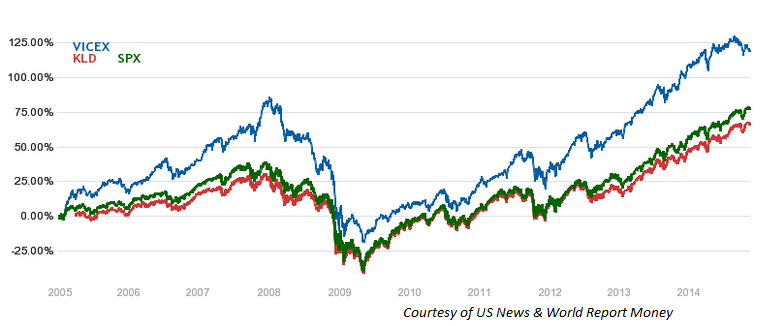Filed under: Market News, Investing

NEW YORK -- More encouraging economic news and friendly signals from the Federal Reserve cheered investors on Thursday, as the stock market climbed to another record high.
The gains came a day after the Fed made clear that it's in no hurry to raise a key bank lending rate, easing a major concern for the stock market.
Eight of 10 industry groups in the Standard & Poor's 500 index rose, led by financial stocks.
"The question isn't 'Why are we up today?'" said Dan Veru, chief investment officer at Palisade Capital Partners in New York. "It's 'Why aren't we up a lot more?' What you're seeing is the U.S. economy growing at a modest pace, not too hot and not too cold."
Veru said it's an environment that allows the Fed to stick to a policy that coaxes businesses to borrow and spend and could fuel further gains for stocks.
The S&P 500 and Dow Jones industrial average closed at all-time highs. The S&P 500 index (^GPSC) gained 9.79 points, or 0.5 percent, to 2,011.36. The Dow (^DJI) surged 109.14 points, or 0.6 percent, to 17,265.99. The Nasdaq composite (^IXIC) climbed 31.24 points, or 0.7 percent, to 4,593.43.
The S&P Financials sector rose 1.1 percent. Bank profits could rise if short-term rates stay low while the rates they charge on longer-term loans creep higher.
The day began with good news about the economy. Fewer Americans filed first-time claims for unemployment benefits last week, according to the Labor Department. Weekly applications fell to 280,000, well below economists' forecasts. The four-week average, a less-volatile measure, also dropped.
Major markets in Europe headed higher as voters in Scotland decided whether to break from the United Kingdom. Germany's DAX advanced 1.4 percent, and France's CAC 40 gained 0.8 percent. Britain's FTSE 100 added 0.6 percent.
Scotland opened polling stations on Thursday for a referendum on whether the country should leave the United Kingdom of Great Britain and Northern Ireland to become an independent state. Opinion polls have suggested the "Yes" campaign favoring independence is neck and neck with the "No" campaign that wants Scotland to stay in the U.K.
"A 'yes' vote is likely to weigh heavily on the sterling and equities," said IG strategist Stan Shamu in a commentary. "A 'no' vote should result in a relief rally and is likely to be positive for the sterling and equities."
The pound was trading at a two-year high against the euro at €1.27, and holding steady against the dollar at $1.64.
On Wednesday in the U.S., the Fed maintained its stance of keeping short-term interest rates near zero for a "considerable time." Investors had speculated that the Fed might hint at an earlier start for rate hikes.
Among companies making big moves on Thursday, Rite Aid (RAD) plunged 19 percent after it cut its profit forecasts for the full year, laying part of the blame on higher costs for generic drugs. The drugstore chain still expects sales of $26 billion this year. Rite Aid's stock fell $1.23 to $5.41.
ConAgra (CAG) said its quarterly profits nearly tripled, sending its stock up $1.47, or 5 percent, to $33.48. Sales for the company behind Chef Boyardee canned pasta and Hebrew National hot dogs were flat, but other costs fell.
Alibaba Group is expected to wrap up its mammoth initial public offering later Thursday, then make its debut on the New York Stock Exchange on Friday under the symbol "BABA." The Chinese e-commerce company could raise as much as $21.8 billion from institutional investors, making it the largest IPO on record in the U.S.
Elsewhere, Hong Kong's Hang Seng finished 0.9 percent lower and Japan's Nikkei 225 gained 1 percent as the yen traded at a six-year low against the dollar. Markets in mainland China, India and Southeast Asia also rose.
In commodity trading, prices for precious and industrial metals fell broadly. Gold dropped $9 to settle at $1,226.90 an ounce, and silver sank 22 cents to $18.52. Copper dropped 5 cents to $3.09.
The price of oil fell on expectations of a quick return of Libyan production and continuing signals of lower global demand. Benchmark U.S. crude fell $1.35 to close at $93.07 a barrel in New York. Brent crude, a benchmark for international oils used by many U.S. refineries, fell $1.27 to close at $97.70 in London.
In other energy trading, wholesale gasoline fell 0.8 cent to close at $2.561 a gallon. Heating oil fell 3.3 cents to close at $2.712 a gallon. Natural gas fell 10.3 cents to close at $3.910 per 1,000 cubic feet
AP Business Writer Youkyung Lee contributed from Seoul, South Korea.
What to Watch Friday:
- The Conference Board releases leading indicators for August at 10 a.m. Eastern time.

















 Michael Tullberg/Getty Image
Michael Tullberg/Getty Image








